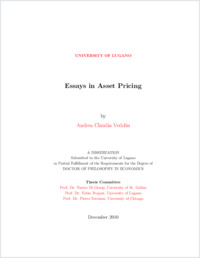Essays in asset pricing
- Vedolin, Andrea Claudia
- Trojani, Fabio (Degree supervisor)
-
16.12.2010
141 p
Thèse de doctorat: Università della Svizzera italiana, 2010 (jury note: summa cum laude)
English
My dissertation aims at understanding the impact of uncertainty and disagreement on asset prices. It contains three main chapters. Chapter One gives a general introduction into the topic of partial information and heterogeneous beliefs. Chapter Two explains the link between credit spreads and the heterogeneous formation of expectations in an economy where agents with different perception of economic uncertainty disagree about future cash flows of a defaultable firm. The intertemporal risk-sharing of disagreeing investors gives rise to three testable implications: First, larger belief heterogeneity increases credit spreads and their volatility. Second, it implies a higher frequency of capital structure arbitrage violations. Third, it reduces expected equity returns of low levered firms, but the link can be reversed for high levered firms. We use a data-set of firm-level differences in beliefs, credit spreads, and stock returns to empirically test these predictions. The economic and statistical significance of the intertemporal risk-sharing channel of disagreement is substantial and robust to the inclusion of control variables such as Fama and French, liquidity, and implied volatility factors. Chapter Three studies the link between market-wide uncertainty, difference of opinions and co- movement of stock returns. We show that this link plays an important role in explaining the dynamics of equilibrium volatility and correlation risk premia, the differential cross-sectional pricing of index and individual options, and the risk-return profile of several option trading strategies. We use firm-specific data on analyst forecasts and test the model predictions. We obtain the following novel results: (a) The difference of index and individual volatility risk premia is linked to a counter-cyclical common disagreement component about future earnings; (b) This common component helps to explain the differential pricing of index and individual volatility smiles in the cross-section, as well as the time-series of correlation risk premia extracted from option prices; (c) The time series of returns on straddle and dispersion option portfolios reflects a significant time-varying risk premium, which compensates investors for bearing common disagreement risk; (d) Common disagreement is priced in the cross-section of option strategy returns.
- Language
-
- English
- Classification
- Economics
- License
-
License undefined
- Identifiers
-
- RERO DOC 27139
- URN urn:nbn:ch:rero-006-110354
- ARK ark:/12658/srd1318412
- Persistent URL
- https://n2t.net/ark:/12658/srd1318412
Statistics
Document views: 390
File downloads:
- Texte intégral: 242
